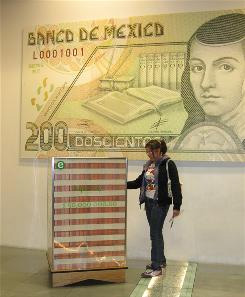
|  |  |  Business News | June 2009 Business News | June 2009  
Mexico's Economics Museum Aims for Solid Financial Future
 Chris Hawley - USA Today Chris Hawley - USA Today
go to original


| | A visitor looks at a stack of 50 million pesos ($4 million) in phony 100-peso bills at the Interactive Museum of Economics in Mexico City on May 21. Behind her is an enlarged 200-peso note. (Sergio Solache/USA Today) | | |
Mexico City If you think an economics museum would be boring, you've probably never lived in Mexico.

In a country with such a traumatic history of financial busts that the current recession almost looks tame in comparison, the government has opened a kid-friendly museum to try to educate young people on how to avoid such meltdowns.

The Interactive Museum of Economics in Mexico City invites visitors to play with giant coins, make their own Visa credit cards and dress up as traders in a mock stock exchange. Many of the values the museum imparts keep your debt down, live within your means and invest in the future are lessons Americans would do well to heed.

"We're trying to create a society that makes better decisions," says Alejandro Zamora, one of the museum's resident economists.

The museum was founded by the Bank of Mexico, the Mexican version of the U.S. Federal Reserve, which has worked to keep the nation's economy stable since Mexico's last financial collapse in 1994, when the peso lost half its value. Zamora and other administrators say it is the only children's museum in the world solely devoted to economics.

The museum occupies an 18th-century former convent in Mexico City's colonial center. It opened in 2006 and attracts about 200,000 visitors a year, mostly grade-school students.

In one section, children can pose with a stack of $4 million in phony 100-peso notes, design and print their own money or wrap themselves in bills the size of beach towels.

In the stock market simulator, high school students don orange and blue vests and roam a trading floor with handheld computers, learning to buy and sell everything from apples to spaceships.

In another exhibit, visitors barter for fish and houses as survivors on a desert island. In another game, they are mayors of small Mexican towns, figuring out how to spend city money.

The concept of "survival of the fittest" is demonstrated with a diorama of children trying to break a piρata. A train set shows how investment works as tiny freight engines carry "capital" between homes, banks and factories.

"It's pretty cool. You learn and have fun at the same time," says high schooler Andres Valdes, 18.

Some of the exhibits are a stretch. A lesson on production costs is delivered through telephones shaped like sneakers, teddy bears, bananas and a glass of milk.

And some things just can't be glitzed up. In one room, decorated to resemble the lobby of the Bank of Mexico, actual administrators at the central bank discuss monetary policy on a video screen.

"Nobody comes in this room because of those hyper-fun economists they put on the video," quips Miguel Aranda, a guide.

Still, the museum's lessons are timely as Mexico's factories, oil sales and tourism suffer through the economic problems of its biggest trading partner, the United States. Last month, the Bank of Mexico reported that the economy fell 8.2% in the first quarter of 2009 compared with the year before its biggest one-quarter drop since the "Tequila Crisis" of 1994-95, when the United States stepped in with a $50 billion rescue package.

Drug-related violence and a bout of deadly swine flu, which forced the shutdown of most of the country's businesses from April 30 to May 6, has worsened the situation. Tax revenue will probably decline by $23 billion this year, and a recovery isn't likely until well into 2010, Finance Minister Agustin Carstens has warned.

Mexico has lived through crunches like this before. From the 1960s through the 1980s, the boom-and-bust cycle became a way of life as Mexican presidents manipulated exchange rates, propped up government-owned monopolies, misspent petrodollars and meddled with the central bank.

Changes in the 1990s gave the Mexican economy a more diverse export base and granted the central bank more independence. Since 2002, the peso has remained relatively stable at 10-14 per dollar, and inflation has been a manageable 3%-6.5%.

The U.S. sub-prime mortgage fiasco, in which millions of low-income Americans signed loans that they couldn't afford, showed how regular citizens can disrupt entire economies through their bad choices, Zamora says.

"One of the issues that led to the sub-prime collapse was the lack of education among regular people about financial consequences," Zamora says. "That's why it's so important to talk economics with the public."

Many of the museum's exhibits stress that Mexicans need to live within their means.

The museum holds seminars for adults on retirement planning and the responsible use of credit cards. It brings in administrators from the central bank for informal chats with the public.

The museum's last room has a huge map where visitors can compare their country's progress with other nations. Glowing plastic towers grow out of the map, showing Mexico's progress in health care, education and gross domestic product per capita a measure of average income.

"This is great. I never understood things like gross domestic product before," says Valeria Morales, 17, as she watches the towers rise and fall. "They explain things in easy terms stuff you don't learn from the news."

Hawley is Latin America correspondent for USA TODAY and The Arizona Republic |

 |
|  |



